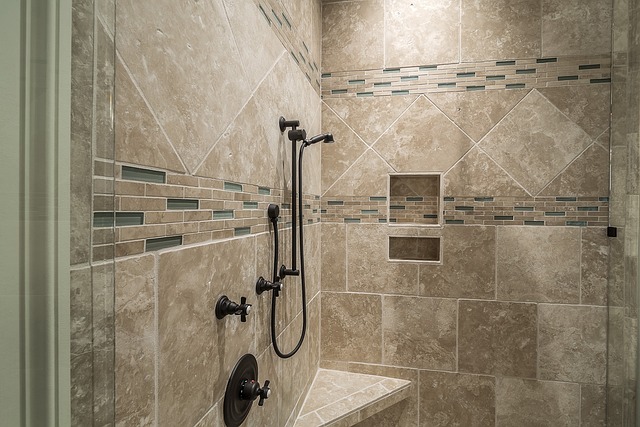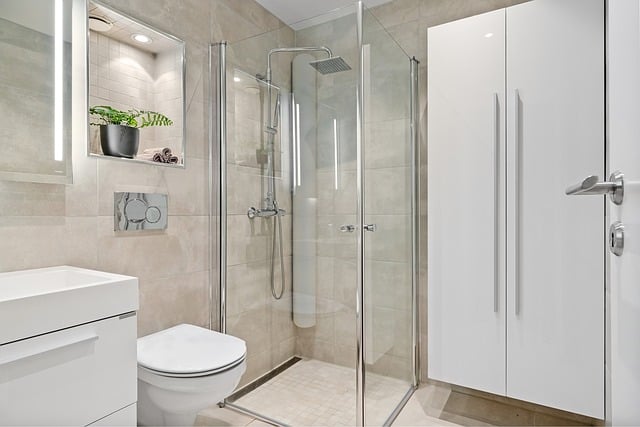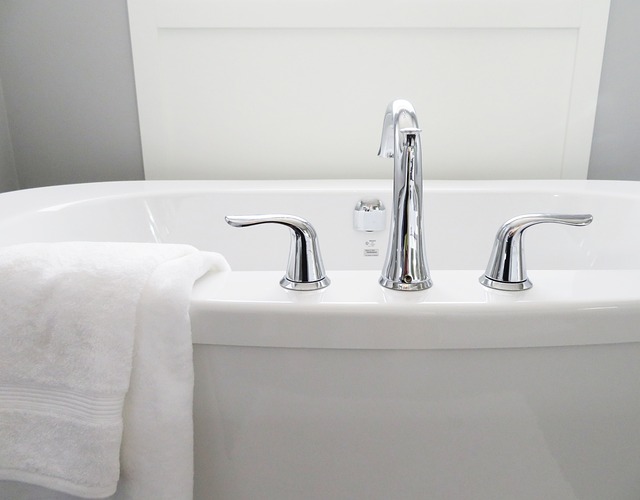Bathroom mold thrives in humid, warm environments exacerbated by poor ventilation, organic compounds in materials, and inadequate cleaning. To prevent and remove shower mold, homeowners should: install or upgrade exhaust fans, use mold-resistant paint and ceramic tiles, maintain low indoor humidity, regularly clean surfaces post-showering, address water leaks promptly, and employ commercial mold removers as needed while following safety guidelines. Proactive strategies like these create a mold-free bathroom environment.
Bathrooms are notorious for fostering rapid mold growth due to their unique microclimate. High humidity, frequent steam, and limited ventilation create the perfect environment for fungi to thrive. This article delves into the science behind bathroom mold, exploring common shower mold problems and their causes. We offer practical solutions, from proactive measures like proper ventilation and mold-resistant paint to effective cleaning techniques, including removing stubborn mold from grout, to help you tackle and prevent this unsightly and potentially hazardous issue.
- Understanding Bathroom Mold Growth: The Ideal Environment for Fungi
- Common Shower Mold Problems and Their Causes
- Proactive Measures: How to Prevent Bathroom Mold from the Start
- Ventilation Solutions: Creating a Mold-Unfriendly Bathroom Atmosphere
- Choosing Mold-Resistant Paint and Other Materials
- Effective Cleaning Techniques for Removing Bathroom Mold, Especially from Grout
Understanding Bathroom Mold Growth: The Ideal Environment for Fungi

Bathrooms create a unique microenvironment that fosters mold growth due to their design and typical usage patterns. High humidity levels are often sustained in bathrooms, especially after showers or when steam is present. This dampness, combined with warm temperatures, provides an ideal habitat for fungi to thrive. The organic compounds found in common bathroom materials like wood, fabric, and paper also serve as food sources for mold.
Shower areas, in particular, are hotspots for mold development due to the consistent moisture. Poor ventilation exacerbates this issue, as it fails to dissipate the accumulated humidity. To combat these issues, homeowners can employ various strategies such as improving ventilation with exhaust fans, using mold-resistant materials and paints, regularly cleaning and sealing grout, and maintaining overall low indoor humidity levels.
Common Shower Mold Problems and Their Causes

Bathroom mold removal is a common concern for many homeowners, especially in areas with high humidity like showers. Shower mold problems are particularly persistent due to the damp environment created by hot showers and poor ventilation. This conducive setting allows mold spores to quickly proliferate on surfaces like walls, ceilings, and even grout.
Several factors contribute to shower mold issues. Lack of proper bathroom ventilation increases moisture levels, creating a breeding ground for mold. Inadequate cleaning practices, especially in hard-to-reach areas like grout, allow mold to thrive. Additionally, using non-mold-resistant paint or materials can accelerate the growth of bathroom mold. Addressing these problems is crucial for maintaining a healthy living space and preventing the need for frequent bathroom mold removal efforts. Effective solutions include investing in high-quality bathroom ventilation systems, using mold-resistant paints and finishes, and adopting regular cleaning routines with special attention to grout cleaning to prevent shower mold problems from recurring.
Proactive Measures: How to Prevent Bathroom Mold from the Start

To prevent bathroom mold from the start, proactive measures are key. Start by ensuring proper ventilation in your bathroom—a well-ventilated space is less likely to foster mold growth. Install or upgrade exhaust fans in your shower and bathtub areas to remove excess moisture quickly. Additionally, consider using a dehumidifier to lower humidity levels, especially during and after showering.
When it comes to aesthetics and functionality, choose materials that are resistant to mold. Look for mold-resistant bathroom paint designed to inhibit the growth of fungi. For high-risk areas like grout, opt for ceramic or porcelain tiles that are easier to clean and less prone to harboring moisture. Regular cleaning is also vital; wipe down surfaces after showering and address any water leaks promptly to prevent long-term damage and mold buildup.
Ventilation Solutions: Creating a Mold-Unfriendly Bathroom Atmosphere

Poor ventilation is one of the primary reasons why bathrooms often become breeding grounds for mold. The high humidity levels created by hot showers and bathing can quickly contribute to a favorable environment for fungal growth. To combat this, implementing effective ventilation solutions is key. An ideal bathroom should have adequate natural or mechanical ventilation to reduce moisture buildup.
Consider installing an exhaust fan that operates automatically when the shower is in use. This will help remove moist air from the room, reducing the likelihood of mold formation. Additionally, ensure there are enough vents in walls and floors to allow for proper air circulation. For a long-term solution, applying mold-resistant bathroom paint and using grout designed to prevent moisture penetration during cleaning can significantly reduce shower mold problems.
Choosing Mold-Resistant Paint and Other Materials

Choosing the right materials can significantly slow down the growth of mold in your bathroom. Opting for mold-resistant paint is a proactive step to prevent shower mold problems. These paints are designed with anti-fungal properties, creating a barrier that discourages mold from adhering and growing. When selecting tiles, choose non-porous options as they are less likely to trap moisture, a key ingredient for mold growth. Additionally, ensure proper ventilation in your bathroom by installing high-quality exhaust fans or openable windows. This helps maintain low humidity levels, which molds thrive in.
When it comes to bathroom materials, considering products labeled as ‘mold-resistant’ or ‘moisture-repellent’ can make a big difference. These materials are engineered to resist moisture absorption, thus reducing the likelihood of mold colonization. Grout, being a common hiding spot for mold, should be cleaned regularly with mold-killing solutions and sealed afterward to prevent future growth. Regular cleaning practices, combined with the right materials, will go a long way in keeping your bathroom free from unsightly and hazardous mold.
Effective Cleaning Techniques for Removing Bathroom Mold, Especially from Grout

Bathroom mold removal can seem like a daunting task, especially when it comes to stubborn shower mold problems. However, with the right techniques and products, it is possible to effectively eliminate existing mold and prevent future growth. One of the most common areas where mold tends to flourish is in the grout between tiles. This is due to the warm, humid environment that bathrooms often provide, coupled with the dark crevices where moisture can get trapped.
To tackle cleaning mold from grout, start by spraying a mixture of water and a mild detergent directly onto the affected area. Use a soft-bristled brush or sponge to gently scrub the grout lines, ensuring you reach all nooks and crannies. For tougher stains or more extensive mold growth, consider using a commercial mold remover designed specifically for bathroom applications. Always follow the product’s instructions carefully, wearing protective gloves and a mask for safety. Once the mold is removed, implement strategies to prevent its return, like improving bathroom ventilation, using mold-resistant bathroom paint, and regularly cleaning with an anti-mold solution to create an inhospitable environment for future growth.
